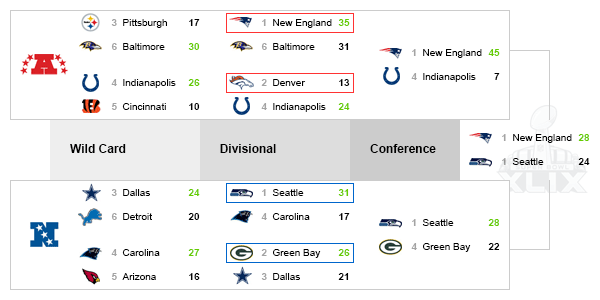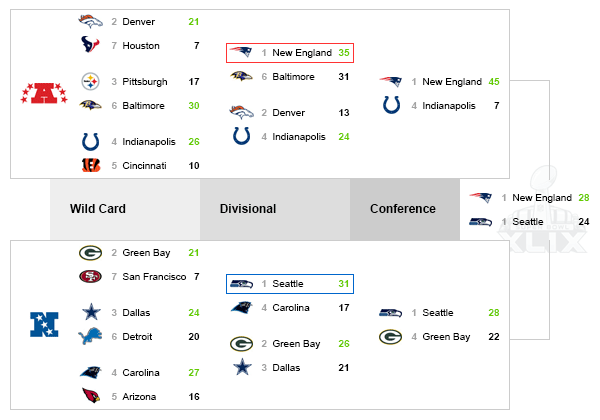With the 2015 regular season well underway, I thought it would be nice to finally write something on what I’ve been thinking about a lot regarding the NFL’s post-season. From a game design point of view, there is one thing that seems illogical to me.

Also, the league has been contemplating the addition of an extra wild card slot in each conference. Which brings me to the intention of this article.
The “redesign” goals of the NFL playoffs:
- Streamline the current structure and matchmaking rules for the road towards the Super Bowl
- Incorporate a seventh team in each conference through the addition of another wild card
So what is wrong with the current post-season setup? Well, technically, nothing. The rules are clear and the audience seems to be fine with how this works. Before I dive into what I would change, here’s a short explanation of those less familiar with the playoffs or the NFL in general.
Conferences & Divisions
- There are 2 conferences: the American Football Conference (AFC) and the National Football Conference (NFC)
- Each conference has 4 divisions (North, East, South, West) of 4 teams each
- The 16 teams in each conference play 16 matches against a mix of teams from their own conference and the other conference
- At the end of this regular season, the highest ranking team in each division (the division winner) will definitely go through to the playoffs
- The 2 highest ranking teams in the overall conference, apart from the division winners and regardless of division, will get a wild card and are also through to the playoffs
- These 2 wild card teams can come from the same division and it’s possible that their regular season record is better than that of a division winner
Playoff rounds & the Super Bowl
- The 2 lowest ranking division winners (seed 3 and 4) and the wild card teams (seed 5 and 6) are matched up against each other in the first playoff stage, the Wild Card Round, where the highest seed faces the lowest seed and has home field advantage
- The 2 teams that survive the Wild Card Round go on to the Divisional Round, where the 2 highest ranking division winners (seed 1 and 2) are waiting, where again the highest seed will face the lowest remaining seed with home field advantage
- The 2 teams that survive the Divisional Round will face each other in the Conference Championship game, where again the highest seed will have home field advantage
- This will result in 1 team emerging as the winner of their conference and this team will face the winner of the other conference in the Super Bowl, held at a predetermined location
The picture below shows how everything turned out in the playoffs last season (2014-2015). The 2 AFC wild card teams (Baltimore Ravens and Cincinnati Bengals) came from the same division (AFC North, usually a competitive division that also contains my favorite team, the Pittsburgh Steelers). The 2 NFC wild card teams (Arizona Cardinals and Detroit Lions) came from separate divisions, but both had a better record than the NFC South division winner (Carolina Panthers).

The strange thing in this setup is visible in the Divisional Round. Why would a second team be allowed to skip the first stage of the playoffs? As seed 2, this team didn’t do anything special, really. Being seed 1, the best team in the conference’s regular season, that’s the achievement. But for some reason, coming second gives you pretty much the same perks as coming out on top. Also, 2 is not a number often used in game design best practices. For example, it’s usually about hitting that boss 3 or 5 times after exposing his weak spot, or getting a podium finish by getting at least in the top 3. But a top 3 with only 4 contestants (the 4 division winners) also doesn’t make any sense. If the top 3 of the division winners would skip the Wild Card Round, number 4 would basically be the only loser and the only team getting mixed up with the wild card teams.
New playoffs setup
So to make being the best regular season team in the conference more of a reward, and to make the Wild Card Round more competitive, I propose only giving the number 1 seed a bye for this first round. Including a seventh wild card spot, this would leave 6 teams to play in the Wild Card Round. Existing matchmaking rules still apply:
- The highest ranking seed (2 to 7 are participating here) will play against the lowest ranking seed. This means there is still a relative reward for finishing higher in the regular season, because in theory you’ll play against a weaker team. The highest ranking team in each match will have home field advantage.
- The 3 winners from the Wild Card Round move on to the Divisional Round, where they are joined by the strongest team in the conference, seed 1. Again, the highest seed plays against the lowest seed and has home field advantage.
Based on last year’s regular season results, the playoffs would look something like shown in the image below. The third wild card spot would in this case go to Houston Texans in the AFC and the San Francisco 49ers in the NFC (their results in the image are fictional and I eliminated them right away to keep the rest of the bracket accurate).

I think this could be a good new setup if the NFL would introduce an additional wild card slot. Next to making that number 1 seed more valuable, it would serve their purpose of creating some additional matches, without putting too much strain on any one team. Also, that extra wild card would increase the chances of a team getting to the playoffs, which a lot of fans will probably appreciate.
Now, I also feel that the road to getting to the playoffs, most notably the way the season’s schedule is determined, doesn’t make any sense at all. So that’s going to be the topic of a future game design article about the NFL.



No comments have been left for this post.